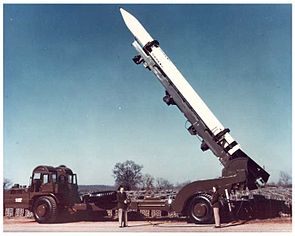MGM-5 Corporal
| MGM-5 Corporal | |
|---|---|
| General Information | |
| Type | Short-range missile |
| Local name | SSM-A-17, M2 |
| NATO designation | MGM-5 Corporal |
| Country of origin |
|
| Manufacturer | JPL and Firestone |
| development | 1947 |
| Commissioning | 1955 |
| Working time | 1955-1964 |
| Technical specifications | |
| length | 13.80 m |
| diameter | 760 mm |
| Combat weight | 5,000 kg |
| span | 2,100 mm |
| drive | Liquid fuel |
| speed | 3,500 km / h |
| Range | 130 km |
| Furnishing | |
| steering | Inertial navigation system |
| Warhead | W7 nuclear warhead with 20 kt |
| Detonator | Programmed detonator |
| Lists on the subject | |
The MGM-5 Corporal - missile was military short-range missile from American production. It was the first US surface-to-surface missile that could be equipped with a nuclear warhead . With this or an alternative conventional warhead, the weapon should attack targets up to 140 km away.
development
The missile was developed by the United States Army in collaboration with Firestone Tire & Rubber Company , Douglas Aircraft Company , Gilfillan Brothers Inc. and the Jet Propulsion Laboratory at the beginning of the Cold War . At that time, the US Army was increasingly striving to get its own nuclear weapons into hand in order to maintain its position and not rely solely on the Air Force . It was believed certain that a future war would be fought as nuclear war . The development initially took place on the test site of the White Sands Missile Range in New Mexico . The American technicians relied on the one hand on the experience and expertise from the German V2 program. On the other hand, we were able to draw on our own experience from the tests with the Private and WAC Corporal rockets . Three operational versions of the Corporal missile have been developed: Type I , II and III .
- Type I - The first production version of the Corporal , which was used from 1955.
- Type II - The frequency of the Type II radar has been changed from that of Type I , and various minor improvements have been made to the missile and launcher. Versions of the Type II with the steering system improved by Gilfillan Brothers Inc. received the designation IIA and IIB .
- Type III - The differences between Type II and III lay mainly in the further modified steering system, which in Type III worked fully automatically, while in Type II several work steps had to be carried out by the personnel on the ground during the flight. The refueling process was also faster and safer with the later version.
The Type III was already developed as a shelf item , that is, the development was completed, but the plans were "put on the shelf". Production should only be started when an urgent need arises. Instead, efforts were now concentrated on the MGM-29 Sergeant .
Mission profile
The Corporal should be used as a tactical nuclear weapon in the event of war in Europe. The first artillery battalion with corporal missiles was set up in 1955. A total of twelve American battalions were equipped with corporals ; six of them were stationed in Europe. The Corporal remained in use until the weapon system was replaced by the MGM-29 Sergeant solid fuel rocket in 1964 .
Although supposed to be the front line of nuclear defense, the Corporal was notorious for its poor reliability and accuracy. The liquid rocket used nitric acid and hydrazine as fuel , which required a complicated and time-consuming preparation for the launch, because the rocket was only refueled with the dangerous substances immediately before being fired. As a result, the ability to react quickly was called into question. The controls were taken over by an improved radar system from the Second World War. Until 1955, their accuracy was less than 50 percent and could only be improved slightly later.
In 1954 the weapon system was sold to the United Kingdom . Test starts by British and German corporal battalions took place in 1959 on the Scottish island of South Uist , where a Royal Artillery test site had been set up between 1957 and 1958 . The British tests of 1959 showed a hit rate of only 46 percent.
Footnotes
- ↑ This made the rocket less sensitive to electronic countermeasures .
- ↑ Cf. Development of the Corporal: the embryo of the army missile program. Vol. 1, p. 230ff
- ↑ Cf. McDonald (2006): "They had, after all, bought an American missile that was dismally inaccurate, notoriously unreliable and astonishingly expensive." (After all, they [the British] had bought an American guided missile that was depressingly inaccurate, notoriously unreliable and was amazingly expensive.)
- ↑ See McDonald (2006)
swell
- Army Ballistic Missile Agency: Development of the Corporal: the embryo of the army missile program. Vol 1. ABMA unclassified report, Redstone Arsenal, Alabama, 1961.
- Fraser MacDonald: Geopolitics and 'the Vision Thing': regarding Britain and America's first nuclear missile. In: Transactions of the Institute of British Geographers. 2006, 31, 53-71. Available for download at [1] .
Web links
For the exact process of development, use and decommissioning, see
- Development of the Corporal: the embryo of the army missile program, vol. 1 . Army Ballistic Missile Agency. Retrieved January 12, 2011.
- Development of the Corporal: the embryo of the army missile program, vol. 2 . Army Ballistic Missile Agency. Retrieved January 12, 2011.
